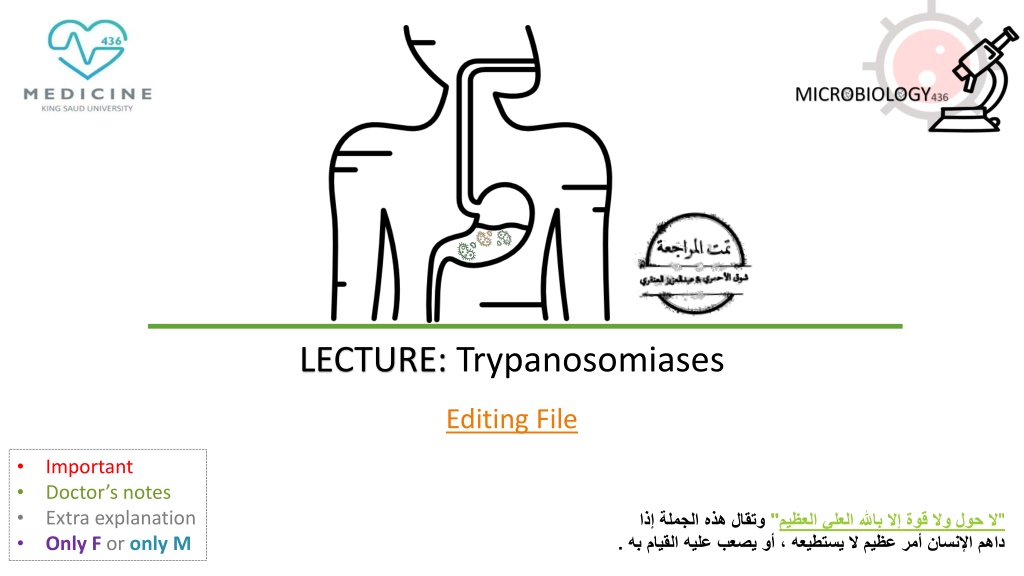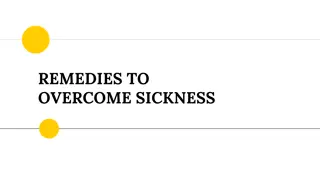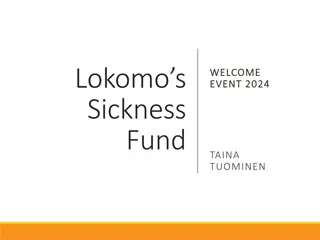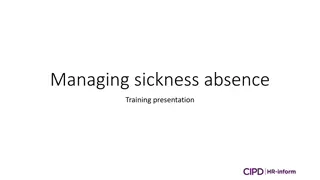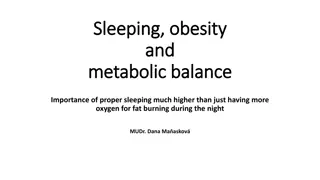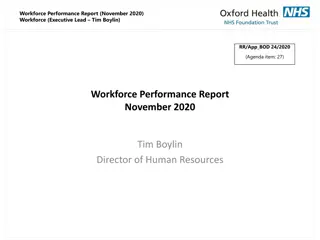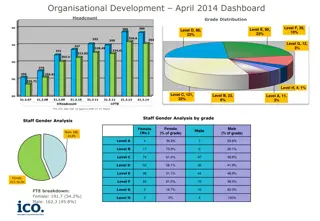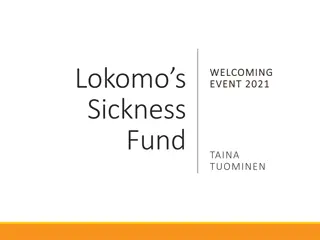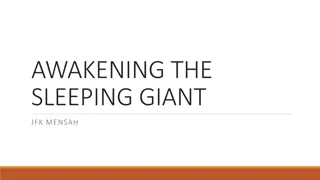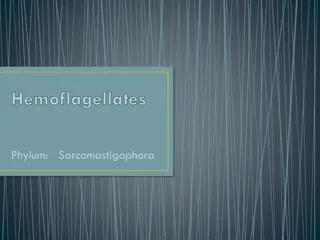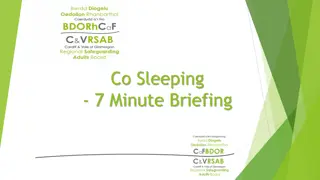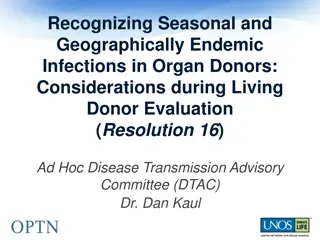Understanding Trypanosomiases: African Sleeping Sickness and Chagas Disease
Trypanosomiases are parasitic diseases caused by Trypanosoma parasites, with African sleeping sickness and Chagas disease being the two main types affecting humans. African sleeping sickness, transmitted by the tsetse fly, can lead to chronic or acute illness and is primarily found in Africa. The disease's transmission, symptoms, diagnosis, and treatment methods are detailed, along with information on the life cycle of the Trypanosoma parasite. Chagas disease, prevalent in Central and South America, is caused by a different Trypanosoma species and primarily affects the heart. Understanding the characteristics and geographical distributions of these diseases is crucial for effective management and control strategies.
Download Presentation

Please find below an Image/Link to download the presentation.
The content on the website is provided AS IS for your information and personal use only. It may not be sold, licensed, or shared on other websites without obtaining consent from the author. Download presentation by click this link. If you encounter any issues during the download, it is possible that the publisher has removed the file from their server.
E N D
Presentation Transcript
LECTURE: Trypanosomiases Editing File Important Doctor s notes Extra explanation Only F or only M " " .
Different stages of Different stages of Haemoflagellates Haemoflagellates Mastigote = Flagella
Trypanosomiasis Trypanosomiasis There are two types of trypanosomiasis that affect humans, they are divided according to their geographical location : 1-African sleeping sickness (mainly affects CNS) 2-Chagas disease in central and south America (mainly affects the heart) African trypanosomiasis, or sleeping sickness : is caused by Trypanosoma brucei parasites in Africa and is transmitted by the tsetse fly(vector). American trypanosomiasis, or Chagas disease: is caused by Trypanosoma cruzi parasites in Latin America and is transmitted by the kissing bug. Trypanosoma brucei rhodesiense: East Africa, Humans and wild and domestic animal reservoirs Trypanosoma brucei gambiense: West and Central Africa, mainly human infection Trypanosma cruzi: cause Chagas disease.
What is African sleeping sickness? What is African sleeping sickness? African trypanosomiasis is a parasitic disease transmitted by the tsetse fly. It gets its nickname sleeping sickness because symptoms can include a disturbed sleep pattern intermediate host Infection occurs through the bite of infected tsetse flies definitive host Humans , domestic cattle and wild animals are the main reservoir host for Trypanosoma T. gambiense: causes a chronic illness T. rhodesiense: causes a more acute illness. Transmission: 1. Trypanosoma are transmitted from human to human through the bite of the tsetse fly which is only found in rural parts of Africa. 2. However, trypanosomes can also be transmitted from mother to child as the parasite can cross the placenta in the blood and infect the baby while it is still in the womb. 3. Contaminated needles can also contribute to the spread of trypanosomes, but this is rare. Diagnosis relies on recognition of the trypomastigote in peripheral blood during fever, sternal bone marrow, lymph node aspirates and CSF. Motile organisms may be visible in the buffy coat . Serological testing is also common as IF and ELIZA. PCR. For early infection: pentamidine / suramin For late infection : eflornithine (Diflouromethylornithine- DFMO) Diagnosis Treatment Dr said not important
Trypanosome Trypanosomelife cycle: life cycle: The trypanosome parasite is first introduced into the mammalian host as trypomastigotes when a tsetse fly takes a blood meal and secretes parasite- filled saliva into the host s skin. Once in the bloodstream the trypomastigotes multiply in the blood, lymph or spinal fluid . Trypomastigote is both the infective and diagnostic stage! Tsetse fly intermediate host
Pathology and clinical picture Pathology and clinical picture 1. A primary reaction: occurs at the site of inoculation of Trypanosomaskin skin stage: chancre1 which resolve in 2-3 weeks. 2. Systemic Haemato-lymphatic stage: 1. intermittent fever 2. headache 3. generalized lymphadenopathy mainly in the cervical and sub occipital region (Winterbottom sign) (very important!) 4. Anaemia 3. Central nervous system stage (CNS): This stage begins when the trypanosome parasites cross from the blood-brain barrier into the spinal fluid ,infecting the CNS including the brain, result in change in behavior ,confusion ,poor coordination ,difficulties with speech and disturbance of sleep (sleeping during day and insomnia at night. (Development of the disease more rapid in Trypanosoma brucei rhodesiense) 3rd stage CNS: CNS involvement in typical case there is daytime sleeping, psychological changes, tremors, convulsions and finally coma. Without treatment, the disease is invariably fatal. Winterbottom s stage Chancre skin stage 1Dermatitis. To summarize 1st stage: chancre. 2nd stage: fever and Winterbottom s sign. 3rd stage: CNS involvement.
CSF lumbar puncture Trypanosoma Can be stained with giemsa or wet microscopic examination Animal reservoir hosts for African sleeping sickness
American trypanosomes American trypanosomes Chaga s American trypanosomiasis, is a tropical parasitic disease caused by the Trypanosoma cruzi. It is spread mostly by insects known as "kissing bugs . The human disease occurs in two stages: an acute stage and chronic stage. In the early stage, symptoms are typically either not present or mild, and may include fever, swollen lymph nodes, headaches, or local swelling at the site of the bite (chagoma) (cutaneous stage). The most recognized marker of acute Chagas disease is called Roma a's sign, which includes swelling of the eyelids on the side of the face near the bite wound or where the bug feces were deposited or accidentally rubbed into the eye. Chaga s disease: disease: Acute stages: Chagoma and Romana s sign. Chronic stage: Cardiomyopathy. The parasites produce focal lymphangitis and oedema at the site of parasites entry (chagoma) after that parasites ( trypomastigote) enter the blood stream and find there way ,mainly on the face near the eyelids ,it produces a swelling of the eye and temporal region with conjunctivitis (ROMANA S sign) (very important) , and also find their way mainly the cardiac muscles cells and RES2. The most constant feature of the cardiac disease is cardiomyopathy , in severe cases can lead to partial or complete heart block which may lead to cardiac failure. Heart damage due to American trypanosomiasis: About two-thirds of people with chronic symptoms have cardiac damage, including dilated cardiomyopathy , which causes heart rhythm abnormalities and may result in sudden death. 2Reticuloendothelial system. To summarize: 1st stage: Chagome. 2nd stage: Romana s sign. 3rd stage: Cardiac disease.
AMERICAN TRYPANOSOMIASIS: AMERICAN TRYPANOSOMIASIS:LIFE CYCLE OF Trypanosoma cruzi Reduviid (Triatomine) bug Parasite when free in blood stream in form (TRYPTOMASTIGOT) but in the tissue it become in form of (Amastigote). T.cruzi causes cutaneous stage (chagoma) Ocular lesion (Romana s sign)
American trypanosomes : American trypanosomes :Chaga s Chaga s disease disease T. cruzi causes a chronic illness with progressive myocardial damage leading to: cardiac arrhythmias cardiac dilatation gastrointestinal involvement leading to mega-oesophagus and megacolon. T. cruzi causes acute illness in children, which is followed by chronic manifestations later in life. , intracellular amastigotes destroy the intramural neurons of the autonomic nervous system in the intestine and heart, leading to megaintestine and heart aneurysms If left untreated, Chagas disease can be fatal, in most cases due to heart muscle damage. Microscopical examination of Giemsa stained blood film. Serology: IFAT Xenodiagnosis3: feeding bugs on a suspected cases. PCR used to detect trypomastigotes. Diagnosis: TREATMENT(not important) benznidazole NITROFURAZONE 3They bring normal bugs and let them feed on human infected with the disease then they check the bug to confirm the diagnosis.
QUIZ: 1. Which of the following is the diagnostic stage of sleeping sickness? a) Amastigote b) trypomastigote c) promastigote 2. Which of the following is the infective stage of Chagas disease? a) Amastigote b) trypomastigote c) promastigote 3. which of the following cause Acute trypanomiasis? a) T. Rhodesiense b) T. Gambiense c) T. Cruzi 4. T. Cruzi produce .. At the site of entry. a) Chancre b) Chagoma c) Romana's sign 5. African man visited the clinic complaining of swelling in the cervical and sub-occipital region. What is his diagnosis? a) Chagas disease b) sleeping sickness c) neither of those 6. Which of the following parasites can cause cardiac failure? a) T. Rhodesiense b) T. Gambiense c) T. Cruzi 7. Which stage of T. Cruzi can be found in the host s tissue? a) Amastigote b) trypomastigote c) promastigote 8. Which of the following parasites produce Winterbottom sign ? a) T. rhodesiense b) T. Gambiense c) Both 9. Which of the following is the vector of T. Gambiense ? a) Testes fly b) Sand fly c) Triatomine A 9. C 8. A 7. C 6. B 5. B 4. A 3. b 2. B 1.
SUMMARY: Trypanosomiasis African Sleeping Sickness Latin America = Chaga s Disease Species Trypanosoma gambiense = chronic Trypanosoma rhodesiense = acute Trypanosoma cruzi Vector Tsetse fly (through its saliva) Kissing/Triatomine bug (through its fesces) 1st chancre (skin) 2nd Winterbottom (lymph) 3rd CNS (coma) Definitive host: humans, domestic cattle and wild animals 1st chagoma (skin) 2nd romana s sign (eye) 3rd CVS (failure) + GIT Pathology Diagnosis Diagnostic & Infective: trypomastigote Trypomastigote in blood or CSF (if CNS involved) + GEMSA stain + PCR+ IF + ELIZA (Note: trypomastigote in blood but turns into amastigote in tissue)
THANK YOU FOR CHECKING OUR WORK, BEST OF LUCK! Hamad Alkhudhairy Shrooq Alsomali Ebtisam Almutairi Reem Alshathri Ghada Alskait Jawaher Alkhayyal Jumana Alghtani Doctors slides
